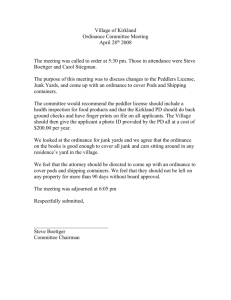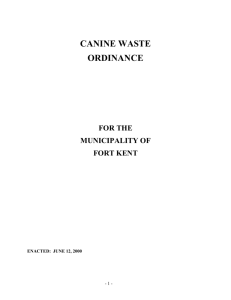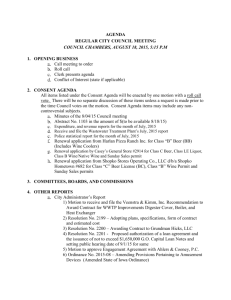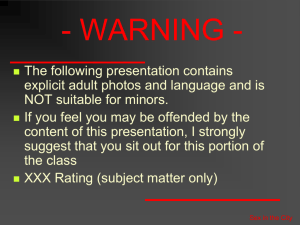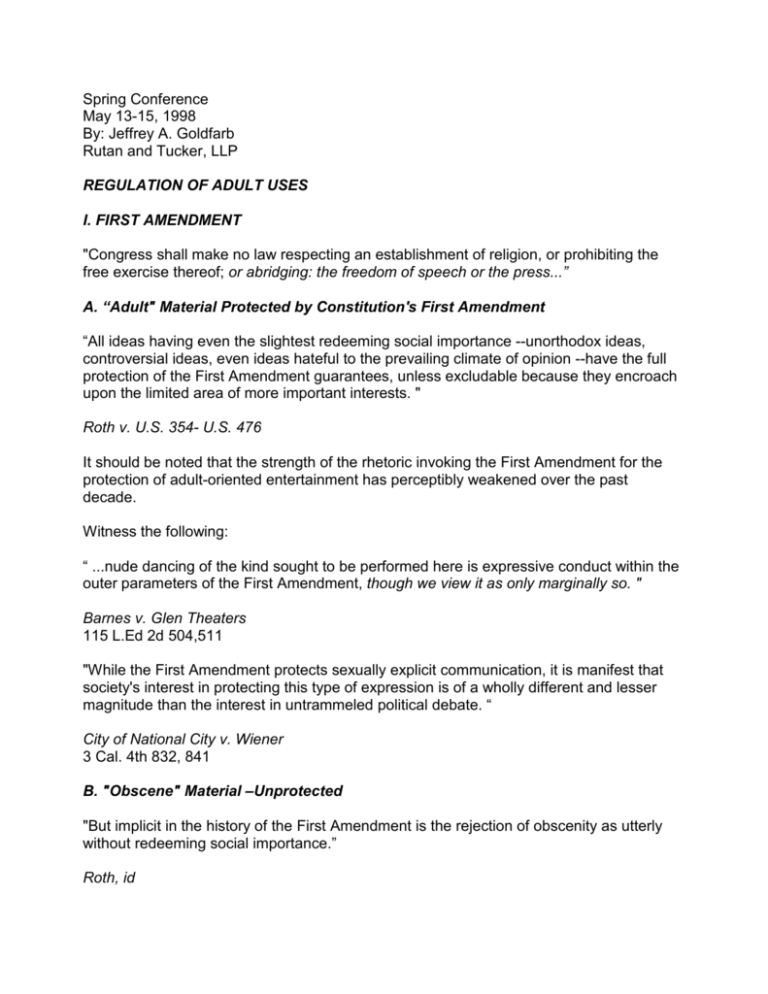
Spring Conference
May 13-15, 1998
By: Jeffrey A. Goldfarb
Rutan and Tucker, LLP
REGULATION OF ADULT USES
I. FIRST AMENDMENT
"Congress shall make no law respecting an establishment of religion, or prohibiting the
free exercise thereof; or abridging: the freedom of speech or the press...”
A. “Adult" Material Protected by Constitution's First Amendment
“All ideas having even the slightest redeeming social importance --unorthodox ideas,
controversial ideas, even ideas hateful to the prevailing climate of opinion --have the full
protection of the First Amendment guarantees, unless excludable because they encroach
upon the limited area of more important interests. "
Roth v. U.S. 354- U.S. 476
It should be noted that the strength of the rhetoric invoking the First Amendment for the
protection of adult-oriented entertainment has perceptibly weakened over the past
decade.
Witness the following:
“ ...nude dancing of the kind sought to be performed here is expressive conduct within the
outer parameters of the First Amendment, though we view it as only marginally so. "
Barnes v. Glen Theaters
115 L.Ed 2d 504,511
"While the First Amendment protects sexually explicit communication, it is manifest that
society's interest in protecting this type of expression is of a wholly different and lesser
magnitude than the interest in untrammeled political debate. “
City of National City v. Wiener
3 Cal. 4th 832, 841
B. "Obscene" Material –Unprotected
"But implicit in the history of the First Amendment is the rejection of obscenity as utterly
without redeeming social importance.”
Roth, id
1. Obscenity Test: Supreme Court
Material is obscene if:
a. Material depicts or describes in a patently offensive way, sexual conduct specifically
defined by state law (see, Penal Code § 211);
b. The average person, applying contemporary community standards would find the work,
when taken as a whole, appeals to prurient 1 interest; and
c. The work taken as a whole lacks serious literary, artistic, political or scientific value.
2. California Definition of Obscene Matter and Live Conduct (Penal Code § 311)
a. "Obscene matter" means matter taken as a whole, * * * which to the average person,
applying contemporary statewide standards appeals to the prurient interest, * * * and is
matter which, taken as a whole, depicts or describes in a patently offensive way sexual
conduct; and * * * which, taken as a whole lacks serious literary artistic political * * * or
scientific value.
"Obscene live conduct" means any physical human body activity, whether performed or
engaged in alone or with other persons, including but not limited to singing, speaking,
dancing, acting, simulating, or pantomiming, * * * taken as a whole, which to the average
person, applying contemporary statewide standards appeals to the prurient interest * * *
and is conduct which, taken as a whole, depicts or describes in a patently offensive way
sexual conduct; and which, taken as a whole lacks serious literary artistic political * * * or
scientific value.
Pen. Code § 311.2
3. Penalty -Distribution of obscene material
1st Offense –Misdemeanor
2nd Offense -Misdemeanor plus $50,000 fine and seizure of material or injunction against
distribution
II. REGULATION OF ADULT USES
A. Definition. Adult uses generally defined as non-obscene material or conduct depicting
or describing "specified sexual activity" or "specified anatomical areas. " These phrases
are defined in the ordinance.
B. General Rule. Non-obscene material and conduct can be subject to reasonable "time,
place, and manner" regulations.
C. Test. A regulation is a reasonable "time, place and manner" regulation and thus will not
violate the First Amendment if the regulation is:
1. Content neutral; and
2. Designed to serve substantial government interest; and
3. Does not unreasonably limit alternative avenues of communication.
City of Renton v. Playtime Theaters. Inc.
475 U.S. 41,50
D. Content Neutral
1. Definition. Regulations which are "justified" without reference to the content of the
regulated speech.
2. Court's Rationale. Adult regulations are "content neutral" so long as the ordinance is
designed to directly address the" secondary effects" of the business rather than the
content of the material displayed or disseminated.
3. Examples.
a. Content Based -"No person shall sell or distribute non-obscene material which depicts
the following: "
b. Content Neutral –“ Any person selling non-obscene material which depicts ******** shall
only do so in the ******* zone of the City and no closer than 1000 feet from residential
structures, etc."
E. "Designed to Serve Substantial Governmental Interest"
1. Rule. Ordinance serves substantial governmental interest if it is designed to "preserve
the quality of urban life. " These goals include: reducing crime, protecting City's retail
trade, maintaining property values, preserving quality of neighborhoods, commercial
districts and urban life.
2. Must be able to prove ordinance serves substantial governmental interest.
a. How. Adoption of ordinance must be supported by studies or court decisions which
show or find that:
(1) Unregulated "adult-oriented uses" tend to create problems or "secondary effects"
which degrade the quality of urban life; and
(2) Regulations adopted by ordinance address the secondary effects created by the
unregulated adult uses.
3. Can rely upon studies conducted by other jurisdictions and court decisions which
reference such evidence.
Renton, 475 U.S. 51
4. Studies used by various cities which show unregulated adult uses degrade quality of
urban life.
a. Supporting locational regulations
(1) Garden Grove, CA
(2) Phoenix, AZ
(3) Los Angeles, CA
(4) Whittier, CA
(5) Indianapolis, IN
(6) Minneapolis, W
,
(7) Cleveland, OH I.
(8) Oklahoma City, OK
(9) Amarillo, TX
(10) Austin, TX
(11) Beaumont, TX
(12) Houston, TX
(13) Seattle, W A
b. Essence of studies -(locational requirements)
Adult uses result in:
(1) Increased crime near adult use.
(2) Decreased residential and commercial property values.
(3) Problems worsen as adult businesses are closer to each other.
c. Adopt studies supporting operational requirements
5. Emerging Trend "Legislative Notice" -Justice Souter, in his Opinion (1 of 3 in plurality)
stated, "In light of Renton's recognition that legislation seeking to combat the secondary
effects of adult entertainment need not await localized proof of those effects...I do not
believe that a state is required to undertake to litigate this issue repeatedly in every case. "
This concept of "Legislative; Notice" was also discussed in Wall Distributors v. City of
Newport News, 782 F.2d 1165, 1169 n. 7, and Postscript Entertainment v. City of
Bridgeton, 905 F.2d 223, 226-27.
Barnes v. Glen Theaters
F. Must Not Unreasonably Limit Alternative Avenues of Communication
1. General Rule. Ordinance or regulations cannot effectively deny persons a reasonable
opportunity to open and operate an adult-oriented business within the jurisdiction.
2. Valid Regulation. Regulations which establish locational requirements which separate
adult uses from each other and other sensitive receptors are valid IF it leaves an adequate
number of sites for location of adult uses.
3 .How much area must be available. Courts have never articulated a minimum. Two
interrelated issues:
a. Quantity of sites.
b. Quality of sites.
4. Quantity --How many sites
a. Focus on sites, not acreage.
1985 -Renton -Focused on available acreage.
1988 -City of Whittier -"We first note that under the terms of the ordinance, estimates of
total acreage is next to meaningless. "
1989 -City of Stanton -Focus on sites -a lot of acreage available -hardly any sites.
61 F.2d 1108
Rationale -some cities included acreage in airports, lakes, sewer plants, streets, etc. , as
areas where adult uses could locate.
b. Required quantity. While courts have not articulated a minimum, at least one court has
held that if more sites available than number of businesses which demand them, the
number of "available" sites is not unreasonable.
Lakeland Lounge v. City of Jackson
(5th Cir. 1992) 793 F.2d 1255
5. Quality --When is site "available"
a. Renton -when it is ample accessible real estate including acreage in all stages of
development from raw land to developed, industrial, warehouse, office and shopping
space that is criss-crossed by freeways, highways and roads.
475 U.S. 53
b. Renton rule modified in Topanga Press v. City of Los Angeles
(1) Not available if "unreasonable to believe that it would ever become available to any
commercial enterprise," e.g., runways of John Wayne Airport are not "available sites. "
(2) Sites in manufacturing and industrial zones may be "available" so long as such sites
are "reasonably accessible to the general public, " e.g., land in middle of oil refinery is not
accessible to general public.
(3) Areas in manufacturing zones which have sidewalks, roads and lighting may be
"available. "
(4) Sites must be of the type which would suit some generic commercial enterprise, e.g.,
huge warehouse may not be suitable for any commercial enterprise.
(5) Sites which are commercially zoned are always “available."
III. ELEMENTS OF ADULT USE REGULATIONS
A. Definition of Adult Uses
1. Regulated Use. Regulated uses must be defined within ordinance.
(See attached ordinance for example.) If too vague, ordinance may be voided by court.
2. Single Use. A single use (i.e., a single showing of adult movie) is not enough to be
considered "adult use. "
Reason -Little or no secondary effect associated with single showing.
3. Court Upheld Language.
Adult uses are a" substantial or significant portion of its stock in trade. "
Adult uses are " regular and substantial course of conduct.”
Adult uses represent a "preponderance of the uses.”
Adult uses are one of the business's "principal business purposes."
B. Method of Granting Permit '
Use objective standards for issuance of permit. "Cannot vest unbridled discretion in
decision-maker."
1. CANNOT USE: CUP findings – i.e., health, safety and welfare standard.
Ebel v. City of Garden Grove
120 Cal.App.3d 399, 406
Dease v. City of Anaheim
(C.D. CA 1993) 826 F.Supp.336
2. CAN USE: "City shall issue permit if"
Distances from other uses
Prohibition of minors
No owners or employees convicted of sex offense within past 5 years
Satisfaction of objective parking standard
etc.
C. Time Limits for Evaluating and Issuing Permits
1. Specificity Required. Ordinance must have specific time period for decision or permit
once application received. (People v. Library One 229 Cal.App.3d 973; FW PBS. Inc. v.
Dallas 439 U.S. 215.)
2. Amount of time. Thirty (30) days has been upheld. With some legitimate justification a
longer period may be acceptable (i.e., 60-day period upheld in TK's Video. Inc. v. Denton
County (5th Cir. 1994) 24 F.3d 705, due to complexities in land use approvals).
3. Permit Streamlining Act unacceptable. Court in Library One refused to say Permit
Streamlining Act provided the required "specific" time period for decision on adult use
permit.
D. License Requirements
1. Disqualification for past activity. Split in courts. Some say no disqualification for past
activities. Others say can refuse to issue license to someone recently convicted of the
type of criminal activity the ordinance seeks to prevent.
a. Examples:
Sex related crimes
Obscenity conviction
Previous loss of adult license
b. If conviction unrelated to harm caused by adult uses, cannot use conviction to deny
license.
Examples:
Auto theft
Tax fraud
Trespassing, etc.
c. California: Disqualifying past criminal conduct must: (1) demonstrate the applicant lacks
qualifications to engage in the activity for which the permit is sought and (2) create a
danger that harm will result. (Perrine v. Municipal Court (1971) 5 Cal.3d 656.)
2. License fees. License fees will be upheld if reasonably related to cost of administering
ordinance.
$100 - Genesa v. Peoria, 619 F.2d 1203
$400 - Bayside Ent. v. Carson, 470 F.Supp. 1140
E. Closing Hours
1. Restrictions upheld. Some cases uphold closing-hour requirements IF reasonably
related to furthering significant Gov. interest (i.e., combating secondary effects).
a. Examples:
10 a.m. -10 p.m. -Mitchell v. Commission on Adult Entertainment, 10 F.3d 123 (3rd Cir.
1993)
6 a.m. -2 a.m. -Sundance Saloon v. San Diego (1989) 213 Cal.App.3d 807
10 a.m. -Midnight -Star Satellite v. Biloxi (1986) 779 F.2d 1074
F. Peep Booth Regulations
1. Internal configuration requirements upheld. Can require all areas be open to view from
a point in public part of establishment, i.e., no doors on peep booths and no openings
between booths.
a. Examples:
Wall Distributors v. Newport News (1986) 782 F.2d 1105
Dumas v. City of Dallas (1986) 648 F.Supp. 1061
Ellwest v. Wenner (1982) 681 F.2d 1234
G. Prohibiting More than One Adult Use Within Single Structure
1. Ordinance upheld limiting buildings to only one type of adult use.
Hart Book Stores v. Ednisten
(1974) 612 F.2d 861
a. Rationale. Studies show the closer discreet types of adult uses
are to one another, the greater secondary effects.
H. Outdoor Advertising
1. Limitations upheld:
No harmful matter (as defined in Penal Code) visible to minors
Must comply with City sign ordinance
I. Prohibit Adult Use from Serving Alcohol.
1. City preempted. Service of alcohol controlled by state through ABC. City cannot
regulate. (Title 20 CCR § 143.3.)
J. Prohibition Against Physical Contact Between Patrons and Entertainers
1. City can prohibit contact between nude entertainers and patrons due to the secondary
effects of increased chances for prostitution and narcotics dealing .
Kev Inc. v Kitsap County
793 F.2d 1053 (9th Cir. 1986)
K. Lap Dancing Regulations
1. Regulating Location of Entertainment Within Establishment
Courts have upheld regulations requiring live nude entertainment only be performed or a
raised stage separated from patrons by a specific distance (BSA. Inc. v. King County (9th
Cir. 1986) 804 F.2d 1104; Kev, Inc. v. Kitsap County (9th Cir. 1986) 793 F.2d 1053)
2. Regulating Tipping
Courts have upheld regulations prohibiting the hand-to-hand payment from patrons to
entertainers. (Kev. Inc. v. Kitsap County)
3. Regulating Physical Contact Between Patrons and Entertainers
Courts have upheld regulations prohibiting intentional physical contact between patrons
and entertainers. (Hang On. Inc. v. City of Arlington (5th Cir. 1995) 65 F.3d 1248; Kev. Inc.
v. Kitsap County)
L. Prohibition Against Nudity
1. Law in flux.
a. Barnes v. Glen Theaters, 115 L.Ed. 20, 504.
(1) Holding: U.S. Supreme Court upheld Indiana ordinance prohibiting public nudity and
requiring performers to wear pasties and G-string.
(2) Plurality Decision with 3 Opinions:
(a) Renquist, O'Conner & Kennedy Nude dancing, while entitled to First Amendment protection, is only "marginally" entitled to
First Amendment protection.
The public nudity statute "furthers a substantial interest in protecting order and morality.”
The prohibition on nudity is not content-based (unrelated to suppression of message)
because" nudity is the evil the state seeks to prevent" not the erotic message conveyed by
the dancer. Erotic message can still be conveyed by minimally clad dancer.
(b) Scalia:
Statute is a "general law" regulating conduct and not specifically directed at expression.
Therefore, it is not subject to First Amendment scrutiny. The regulations punish all nudity,
not just nudity in conjunction with expression. Different if law prohibited conduct "precisely
because of its communicative attributes" in which case it would be unconstitutional (i.e.,
burning flag).
(c) Souter:
Nude dancing is entitled to First Amendment protection.
We need not determine whether society's interest in morality and order is a sufficiently
important governmental interest BECAUSE court can take judicial notice that nude
dancing in adult establishments creates undesirable secondary effects of increased crime,
decreased property values and which implicate sufficiently important governmental
interests.
(3) What rationale can be applied:
Rule: "When fragmented court decides case and no single rationale explaining the result
enjoys the assent of 5 justices, the holding of the court may be viewed as that position
taken by those members who concurred in the judgment on the narrowest grounds."
Marks v. U.S.
(1977) 51 L.Ed.2d 260
Souter ruled on the narrowest ground, i.e., this case is qualitatively identical to all other
adult entertainment cases: regulation aimed at reducing secondary effects.
(4) Subsequent cases:
(a) Triplett Grille v. City of Akron
(6th Cir. 1994) 40 F.3d 129
Ordinance prohibited all nudity in public places. Court held ordinance overbroad because
it did not limit prohibition to places where nudity would have undesirable secondary
effects. (Relied on Souter rationale.)
(b) O'Mally v. City of Syracuse
(ND NY 1993) 813 F.Supp. 133
Ordinance stated, "No person shall appear within the City in a state of nudity." Ordinance
was justified by need to protect public morality and order. Court upheld City ordinance to
Renquist's opinion that preserving order and morality was an important governmental
interest.
b. California
(1) Penal Code Preemption. Penal Code § 318.5 preempts cities from regulating nudity
itself in "theaters," but not nudity in other places.
(2) Morris v. Municipal Court (1982) 32 Cal.3d 553. State has right through ABC to
regulate use of liquor and can prohibit nude dancing in liquor-serving establishments due
to" significant governmental interest."
But, City preempted from regulating alcohol and absent alcohol, City has no other
significant governmental interest.
(3) Future. Morris based on federal cases which may no longer be " good law" since
Barnes.
M. Criminal Enforcement of Adult Oriented Business Licensing regulations.
1. Problem with Criminal Enforcement.
In Lancaster v. Municipal Court (1972) 6 Cal.3d 805, the Court concluded that the State
Legislature has occupied the field of local criminalization of sexual activity. Therefore adult
oriented businesses will argue that the City is preempted from criminally enforcing
regulations contained in its Adult oriented business licensing/zoning ordinance.
2. Potential Solutions to Problem.
a. If the specific regulation being enforced has nothing to do with sexual activity, such as
the mere obligation to obtain a license, the preemption argument is inapplicable.
b. If the regulation being criminally enforced does touch upon sexual activity, such as
prohibitions against patron/ entertainer physical contact, the municipality can argue that,
under Brix v. City of San Rafael (1979) 92 Cal.App.3d 47 comprehensive licensing
regulations which affect sexual activity are not preempted by the States occupation of the
field of criminal sexual conduct.
____
1
"Prurient" -Shameful or morbid interest in nudity, sex, or excretion.


